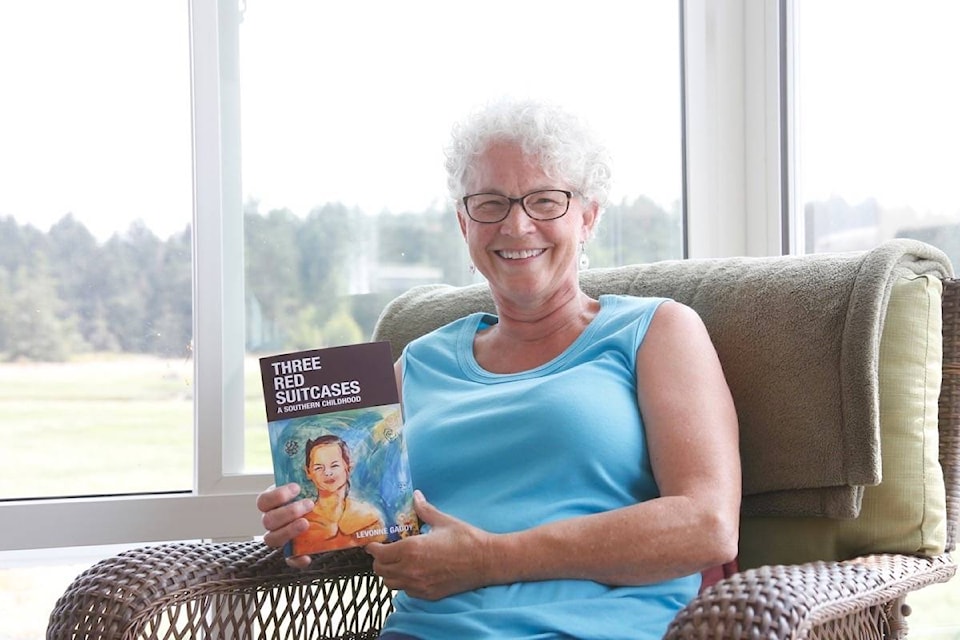People are shaped, and sometimes scarred by their childhood.
For Levonne Gaddy, just surviving it was a feat.
Gaddy, who is of African-American descent, grew up in ’50s and ’60s North Carolina — to riots, to burning churches and many more forms of violence as racial integration began.
Being part of the black community at the time was difficult and dangerous, but what made it moreso was that Gaddy looks white.
Gaddy survived her childhood, marred also by family violence, but not unscathed. Even now, at age 63 living in Parksville and Mexico, she continues to explore new ways of healing.
Her book, Three Red Suitcases: A Southern Childhood, which came out in June, is one method of healing she’s been working on for many years.
But, as if re-living an often painful childhood through writing a memoir weren’t enough, Gaddy has also had herself recorded reading the memoir for an audiobook. She hopes to have the audiobook out by the end of the summer. Right now, she’s listening to it as part of the editing process.
“Reading it… I’ve experienced things that I had no idea I was still holding onto, and still had deep feelings about,” she said.
Nonetheless, she said, “When I was in it (my childhood), it felt like hell, but I have to tell you, it’s also the greatest gift in my life.” That’s because, just like herself, she can see that nothing is black or white.
“I was classed as black and lived in a segregated black world,” said Gaddy of her childhood.
“My full world experience, for the most part, was African American… So this child is growing up, in real time, getting feedback from blacks that you look funny or you look different, and getting from whites, when I’m with a black person, getting the most awful, nasty looks because their assumption is this is interracial and what’s this white girl doing with these black people, or especially with a black man or a black boy.
“I could get the nastiest, meanest looks. My real world was showing me people being angry and concerned about who I was, and I’m just living,” she said.
“Then of course there was the news in the evening. My parents and everybody was glued to their TV watching the riots happen in North Carolina and California, in the south, bombings of churches, Martin Luther King (Jr.) calling for everyone to be racially connected, sit-ins at the segregated establishments across the state and across the south, people missing because their advocating for black people, people not being able to vote. My parents couldn’t vote because they didn’t have the right yet early in my life.
“It was just a very tumultuous time… and I feared for my life. I feared that blacks were going to kill me because I looked white, and I feared that whites were going to kill me because I was with black people. So I grew up with all this very heated, racial… just hell, really.”
But with time comes some very different perspectives. At age 11, Gaddy became a live-in caregiver for an elderly white woman. Considering that job later in life (which she wasn’t paid for), Gaddy came to think of it as child slavery.
But, more recently, Gaddy’s perspective on that job has turned around completely. Now she feels it in fact gave her freedom, and helped her to survive her own family.
“Adults weren’t really saying that I had to do anything,” she said. “I knew I could go back to my home and live at any time, and I also felt that I could stay with Mrs. Richardson for as long as I needed to… I really was experiencing a good deal of freedom, and that must have been really good for a child to have that kind of control, even though it can look like you’re out of control… I have gratitude for that,” said Gaddy. Though she added that, “In 10 years, who knows what I’ll be thinking.”
Gaddy’s racial heritage is complicated, including African American, European and Cherokee, and it has meant that a lot of cultural pain has been handed down to her. But it has given her a perspective that she cherishes.
“I’ve been able to see the world through these black eyes, and through white eyes,” she said, while learning about her Native American heritage as well.
And while she hopes her book is an entertaining read, she also hopes that it shares her healing with others, and helps to heal them as well.
“If there’s anything I’m here on this Earth to do, it’s to heal myself and to heal what my parents have past onto me,” she said. “Because in that healing, I contribute to the healing of the world, and everyone in their healing, in their individual healing, contributes to the healing of the world.
“Interracial conflict, so much of that has to do with fear, it has to do with pain. Beneath that is some wound that needs attention and healing. And so I really believe that if all of us, human beings would attend to that unbearable pain and those unbearable fears… that alone would increase the compassion in the world and (cause) a reduction in the need to fight and a reduction of violence. I really believe that.
“If we can listen to other people spewing their pain and their fears and whatever without doing it back, that really contributes, and I think we’re able to do that if we are healing ourselves… if we have compassion towards ourselves.”
Gaddy’s book is available for order through Amazon and Chapters. Gaddy will also hold a book reading and signing from 1 p.m. to 2:30 p.m. at the Surfside RV Resort office (200 Corfield St. North, Parksville) on Saturday, Aug. 11.
For more info about Gaddy, go to levonnegaddy.com.
